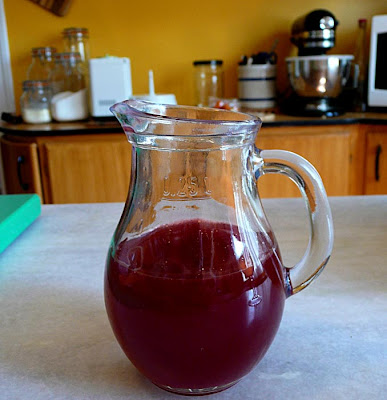This morning's low: 19ºC. Today's predicted high: 31ºC. That's basically 70º and 90ºF.
In 2007 and 2008, our summer weather was rainy and cool — I almost said "chilly." Yesterday morning I walked Callie at 7:15 a.m. and it was warm and gorgeous out in the vineyard, even that early. The ground is dusty dry and the grass is parched. I was wearing shorts and a T-shirt. Callie got stung by a bee (she's fine). It's pretty warm when insects are active that early in the morning here.
The most pleasant thing about this weather is that we can sit out on the front terrace in shorts and T-shirts until very late at night. In fact, the sun doesn't go down until about 10:00 p.m., and total darkness doesn't fall until 11:00. By then there are bats swooping through the air around our house, gorging themselves on insects. We are located at a very northern latitude — north of Quebec City, for example, and Duluth, Minnesota — that explains the late sunsets.
We haven't had any measurable rain since June 13. That's amazing. This is a temperate climate, with frequent rains and moderate temperatures. You wouldn't know it right now. We're having a heatwave. Our weather seems to be coming from the Sahara.
The garden is growing great. Weeds took hold, however, under the sweet corn and lima beans that we planted from seed back in May, and rain earlier in June only encouraged them. Yesterday morning, I spent a couple of hours on my hands an knees out in the garden, pulling deep-rooted grasses and other invasive plants that had started to crowd out our garden plants. I had to dress in long pants and a long-sleeve shirt to avoid being eaten alive by bugs.
I swatted gnats and flies the whole time, sweated until my clothes were soaked and my glasses were dripping perspiration, and wondered if it was really worth it. I ended up with bug bites on my face and ears! Only good crops of corn and lima beans later this summer will make me feel better about all the trouble and effort. And I didn't finish, so I'll have to go and do more weed-pulling this morning.
All the doors and windows in the house, with the exception of those facing west into the afternoon sun, are wide open all day now. It was 28ºC, or 82ºF+, in the house yesterday afternoon, but there was a breeze. At 6:00 this the morning, we opened everything wide again to let in as much cool air as possible.
 Early on a June morning on the paved route touristique
Early on a June morning on the paved route touristiquethrough the Touraine vineyards, a mile from our house
This weather is starting to remind me of the summer of 2003, when we first arrived in Saint-Aignan. It was hotter than hell that summer. We had been living in the San Francisco Bay Area for nearly 18 years — most of that time in San Francisco itself. If you know S.F., you know that there is basically no summer weather there. It's foggy, windy, and cool in June, July, and August. We weren't used to heat.
In the great French dog days — La Canicule — of 2003, at some points we thought we might not survive. It was 90 to 100ºF every day for weeks on end in July and August. The ground and all the vegetation was parched. The house didn't ever get a chance to cool down. Many older people died, all around northern France, of heat exhaustion. Not many houses have air conditioning here. I hope our weather moderates just a little for the rest of the summer of 2009.



















































